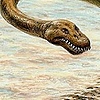HOME | DD
 DrPolaris — Tanasaurus lentus
DrPolaris — Tanasaurus lentus

#animal #dinosaur #speculativefiction #ornithischian #speculativeevolution #speculativebiology
Published: 2021-02-10 23:11:57 +0000 UTC; Views: 17098; Favourites: 183; Downloads: 7
Redirect to original
Description
During the Late Eocene, several dinosaur lineages of Asian origin successfully made the crossing into North Africa. One of the most notable of these were the Thescelosauroid Ornithischians. Tracing their line of descent from the Late Cretaceous genus Thescelosaurus itself, these herbivores survived into the Paleogene, migrating into Asia by the beginning of the Eocene. Here the group underwent a moderate diversification event, leading to a succession of forms that ranged from small forest dwellers to somewhat large, heavy-set semi-aquatic herbivores such as the well known genus Irrawaddya. It was from animals such as this that all African Thescelosauroids were descended, likely having island hopped across the Tethys by at least 40 mya, when the oldest known forms appear in the fossil record at Faiyum. Thescelosauroids thrived in their new environment, with a notable evolutionary trend for an increase in body size. Ancestral genera were modestly sized, measuring up to 3m, but by the Oligocene significantly larger representatives emerged, such as the semi-aquatic Lacustrisaurids and the first fully terrestrial Seismotitanids. Tanasaurus was among the most basal of the latter, an already impressive 8m beast recovered from the Late Oligocene Chilga site of Ethiopia. T. lentus was flexible browser, possessing a graviportal posture, slender jaws and a powerful muscular neck. Interestingly, Tanasaurus was already significantly larger than the Hadrosaurs with which it shared its environment, which tended to be rather modest in size. The holotype is represented by a partial upper jaw, parts of the braincase, a near complete right forelimb, ribs, gastralia and vertebrae from the neck and tail. In life, the neck was moderately elongated and flexible, allowing the square tipped, narrow bill and jaws access to wide array of plant material both at ground level and high in the trees. Plant matter was then processed by numerous file-like teeth arranged into chopping batteries. In all, while relatively rare in the Oligocene, Seismotitanids would later explode in terms of range and diversity in the Miocene, when savannah biomes spread to cover much of Northern Africa and Eurasia. Their odd mixture of traits, combining the size and bulk of Titanosaurian Sauropods with the derived chewing apparatus of an Ornithischian, in addition to their capability of both browsing and grazing, enabled Seismotitanids to thrive beyond their African homeland.
Related content
Comments: 7

👍: 1 ⏩: 0

👍: 0 ⏩: 1

👍: 0 ⏩: 1

👍: 0 ⏩: 1

👍: 0 ⏩: 0

👍: 1 ⏩: 0

















